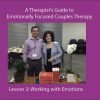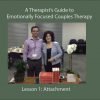Sometimes relationships can feel like a lot of work. What once was an easy and joyful engagement with a caring compassionate other can slowly turn into an exhausting exchange of complaints and a mutual sense of deprivation and dissatisfaction.
Over time our once best friend can slowly begin to seem like an adversary, and our once biggest source of good feelings and accolades can slowly become a source of negative feelings of falling short or not being good enough.
Fortunately, we now have a remedy to this steady decline of good-will that befalls so many relationships.
Want to know what it is? Then you are in luck...
In this article and the accompanying video which is included below, I will tell you exactly how to turn a negative relationship around.
The big news item is that the fault is not in your partner, nor in yourself for that matter. Instead the real culprit of negativity in your relationship, is the negative cycle of interactions in which you have gotten stuck.
Emotionally-focused couples therapists have mapped out the nature of the negative cycles that take over perfectly good relationships and turn them into battle fields of negativity. They have also found a way to get couples unstuck from these patterns so they can regain and even strengthen the positive connection they had when they first met.
In the video I am about to show you, you will see how one married couple found a way to turn their relationship around by heeding the insights of emotionally-focused therapy.
Understanding Your Negative Cycle:
A negative cycle is a self-pertuating merry-go-round where what one person says or does creates negative feelings in the other person, and what the other person says or does creates negative feelings in the first person. Couples thereby get stuck in a negative spiral or vicious cycle that keeps them separate from the love, the closeness, and the good feelings they really want.
Emotionally-focused couples therapists have studied the steps involved in the negative cycles that squeeze the love and connection out of relationships. They have made it easier to get out of these patterns, by giving us the tools we need to understand them, and providing us with insights into how to place our feet differently.
The individual steps in any negative relationship cycle can be broken down in the following way:
Primary emotion: the real emotional response a person has to something their partner says or does) or doesn't say or do. This emotion is often vulnerable and can make the person feel exposed or weak. It tends to be an emotion like sadness, pain/ rejection, shame, or fear.
Secondary emotion: the emotional response a person has to the way their partner has made them feel (the primary emotion). This emotion is often a response to the more vulnerable emotion that makes a person feel stronger or at least makes the person feel less exposed or vulnerable. Sometimes this emotion will be one of anger, contempt, or anxiety
Perception: The conclusion or interpretation a person makes about their partner based on their secondary emotion. If the person feels angry, they are likely to interpret their partner's behavior as deliberate and ill-intentioned. If the person feels anxiety, they are likely to interpret their partner's behavior as a sign of danger and bad things to come.
Behavior: How a person acts or reacts based on their secondary emotional reaction and interpretation to their partner. If a person feels anxious in response to their partner, then they are likely to placate in order to avoid further conflict, to freeze up and go into problem-solving instead of staying engaged with their partner's feelings, or to shut down and withdraw in order order to protect themselves.
When these individual steps are connected together in a chain for both partners in a relationship, they can be depicted as an infinity cycle that loops back and forth between partners in a continuous spiral:
In this case what is below the grey dotted line is also often below the threshold of a couples awareness.
Why Couples Get Stuck:
Partners who have grown accustomed to feeling criticized or shut out by each other are mostly in touch with their more reactive secondary emotions, and not with the more vulnerable primary emotions and their underlying unmet needs. They lead conversations with angry criticism, or a tendency to anxiously withdraw, appease, or problem-solve.
However, because how they respond to their partner exacerbates the very problem that occasions the criticism or withdrawing to begin with, they get stuck in a lose-lose situation where both are unhappy.
A person who appeases and placates in order to stop the unbearable criticism from their partner, still remains hidden behind a wall of empty words and empty intentions, and this only makes the critical partner feel more alone, more disconnected, and more critical.
A person who criticizes every little thing their partner does, instead of expressing an underlying need for attention or closeness, only ends up making their partner feel aversive to spending time with them and shutting down the very emotional connection they are yearning for.
How to Get Out of Your Negative Cycle:
What I will show you in my video is how a couple can begin to understand the things they argue about in terms of the steps of the infinity cycle. You will get to understand not only why couples fight, but also what they can do to stop the negative cycle and begin to create a more positive one.https://www.youtube.com/embed/fBIuhs8eJIk?version=3&rel=1&fs=1&autohide=2&showsearch=0&showinfo=1&iv_load_policy=1&wmode=transparent
As the video shows, this married couple were able to shift out of their negative cycle by getting more in touch with their primary feelings and underlying unmet needs.
By communicating not just about these, but from these, they were able to transmit a different but also more congruent emotional message. In other words, they were showing their partner what they really felt.
The wife could now let her husband in on how much he really matters to her and how desperate she can get sometimes when she feels unsure of her importance to him.
The husband, in turn, then no longer needed to get his defenses up, but could now feel pulled into an emotion of compassion and love for his wife and a concern with not wanting her to feel so alone. This allowed the husband to reassure his wife and to hear her past complaints, not as a criticism of him, but as a longing for him.
Blamer Softening and Withdrawer Re-engagement:
The video shows how the wife could choose to approach her husband differently in order to get a different response. In emotionally focused therapy this dance move is often referred to as "blamer softening" because the wife here was able to express her dissatisfaction in a softer and less critical way.
The counterpart to "blamer softening" is "withdrawer reengagement".
In the example of the married couple in the video, this would entail the husband making a new dance move and thereby calling for a different response in his wife.
The husband could let his wife in on how small and rejected he feels when he hears his wife criticize him or make snark comments about ways in which he is not satisfying her.
Instead of withdrawing into his cocoon, he could reengage by letting his wife in on his hurt and saying that he wants to be close but sometimes feels intimidated and unsure if she even likes him. This in turn, might make his wife see his absenteeism in a new light, and would already make her feel more connected with his inner thoughts and feelings, which is what she has really been longing for.
Emotionally Focused Couples Therapy Can Help You Get in Sync Again:
As you can see, emotionally focused couples therapy offers us a roadmap for how to turn negative relationships around, by helping us understand the dance steps that get us in trouble, as well as the dance steps that will get us in sync.
In conclusion therefore:
The next time you find yourself in a negative merry-go-round with your partner, ask yourself: What are the steps of our own little dance, and what would be required for us to step into a different one?
* * *
About me: I am a psychologist and Certified Emotionally-Focused Couples Therapist in Houston, TX. I help couples get unstuck from their negative patterns and recreate the love, connection, and respect they both yearn for.




























